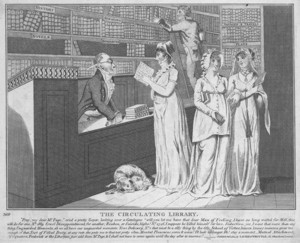One-Day Interdisciplinary Postgraduate Conference
Saturday 13 November 2004 at the King's Manor
THE CENTRE FOR EIGHTEENTH CENTURY STUDIES AND THE BRITISH ASSOCIATION FOR ROMANTIC STUDIES
ROMANTIC TEXTUALITY: 1770-1830

Convenor: Alex Watson
In association with the Centre for Eighteenth Century Studies at the University of York, the British Association for Romantic Studies presents a one-day postgraduate conference on the subject of 'Romantic textuality'. The papers focus on a number of different authors - such as William Blake, Mary Wollstonecraft, Anna Laetitia Babauld, William Wordsworth, Walter Scott, Anna Eliza Bray, Charlotte Smith, Mary Robinson, Ann Radcliffe - and address a wide range of topics: how texts were bought and sold in the period; how authors and editors modified the material forms of certain texts to ensure they would be read, studied and consumed in certain ways; and who read which texts - and why.
Late eighteenth and early nineteenth-century British literary culture was marked by its fascination with the materiality of the text. The works of antiquaria n editors, such as Thomas Percy, and forgers, such as Thomas Chatterton and James Macpherson, initiated a sophisticated awareness of the text as a cultural artefact bound in historical conflicts, negotiations and appropriations. Such volumes also generated widespread enthusiasm for literary works that combined poetry or prose with a wide variety of textual forms: lexicographical indexes, marginal glosses, explanatory footnotes, polemical headnotes, pseudo-historical documents, catalogues of antiquities, topographical and architectural drawings, genealogies, histories and bibliographies. At the same time, market competition encouraged authors and publishers to pay more attention to book design, typography and illustration. In recent years, scholarship in many disciplines has drawn renewed attention to the text as it is realised in the physical form of a book. Romantic-period scholars have furthered our understanding of Romantic textuality and the context(s) it operated within: the diffusion of texts through circulating libraries and in clubs, associations, debating societies, salons, taverns, coffee houses; the increasing fragmentation of the reading public; changes in the nature of authorship; the emergence of the professional critic; authors' revision of successive editions of their work.
9.15-9.45: Registration
9.45-10.00: Introduction
10.00-11.30: Panel A 'Romantic Texts' (Chair: Alex Watson)
Ben Whitworth, University of Oxford, 'The Romantic Hymn: Text, Authorship, Authority'
Mark C. Crosby, University of Oxford, 'Damn the King: William Blake and the Textuality of Sedition'
Jenny McAuley, University of Durham, 'Wordsworth's The White Doe of Rylstone (1815): A Gothic Revival Text
11.30-11.45: Coffee
11.45-12.45: Panel B 'Women writers and readers 1' (Chair: Angus Whitehead)
Paul J. Sisko, University of Lehigh, 'Female Aristocratic Buyers of Wollstonecraft's 'A Vindication of the Rights of Woman'
Dianne Duffy, University of Manchester, 'Personal Histories, Public Tex: The Early Historical Romances of Anna Eliza Bray, 1790-1834'
12.45-1.45: Lunch: King's Manor Refectory
1.45-2.45: Panel C 'Women writers and readers 2' (Chair: To be confirmed)
Jennifer L. Black, University of Lehigh, 'Women Writers and their Female Audiences in the Hookham and Carpenter Archives, 1791-8'
Laura J. Smith, ' "…to lay the first stone of a noble building and to plant the first idea in a human mind." Romantic Textuality and Anna Laetitia Barbauld's Works for Children'.
2:45-3.00: Coffee
3.00-4.00: Panel D 'Romantic Textuality and Beyond' (Chair: To be confirmed)
Padmini Ray Chaudhury, University of Edinburgh, 'Re-citing Romanticism'
Jessica Laccetti, University of London, 'Subjective Mimesis to Multi-Mimetic Subjectivities: The Representation of Becoming Individuals in Contemporary Women's Hyperfiction'
4.00-5.00: Open Discussion
